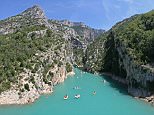On the frontline of Afghanistan's attempts to boost warzone tourism in 'oasis' of Bamiyan... despite the conflict around it
- Bamiyan once sheltered Buddha statues, but were blown up by the Taliban
- However, since then the province has been largely spared from conflict
- Named this year's cultural capital of South Asia, though few are optimistic
- Home to the world's oldest cave oil paintings and first Afghan national park
Trudging halfway up a jagged goat trail, guide Mohammad Ibrahim extolled the panoramic view: a vast, ancient landscape of russet-hued cliffs that is on the frontline of Afghan efforts to jump-start warzone tourism.
Bamiyan - famous for empty hillside niches that once sheltered giant Buddha statues that were blown up by the Taliban - is a rare oasis of tranquility that has largely been spared the wrenching conflict that afflicts the rest of Afghanistan.
Once a caravan stop along the fabled Silk Road, the central Afghan city was recently named this year's cultural capital of South Asia, igniting hopes of restoring its place on the global tourism map.

Bamiyan, in central Afghanistan, hopes to boost tourism this year after being named cultural capital of South Asia
One obstacle, however, remains: Bamiyan is hemmed in by conflict.
Figuring out how to get to the ancient city - endowed with stunning landscapes but wedged between volatile provinces - itself is a challenge.
But that doesn't stop Ibrahim, who is head of the local tourism association with a penchant for Indiana Jones-style straw hats, from making his sales pitch.
'Bamiyan has caves with the world's oldest oil paintings, the country's first national park and during winter it's home to Afghanistan's only ski slopes,' he said.
Hiking up to the ruined ramparts of Shahr-e-Gholghola - the City of Screams, which was destroyed by Genghis Khan in the 13th century - Ibrahim stopped to catch his breath and picked up a spent bullet shell from the ground, one of many Soviet-era casings that litter the windswept trail overlooking the sandstone cliffs and snow-clad pyramids of the Hindu Kush range.
'Bamiyan is the envy of Afghanistan - it has peace,' he said.

However, the picturesque province is hemmed in by conflict, which continues to rage on in neighbouring areas
Pre-civil war days are a subject of whispered nostalgia in Bamiyan, when it wielded control over strategic mountain passes connecting trade routes from India, China and Persia and the local markets swarmed with stoned backpackers hopping overland on the so-called 'hippie trail'.
But it has failed to revive the heyday of tourism after decades of war, including the Taliban's 1996-2001 reign when they destroyed two massive Buddha statues carved into sandstone cliffs, labelling them an affront to Islam - an act globally condemned as 'cultural terrorism'.
Reliable statistics are hard to come by but officials admit that the number of foreign tourists has fallen off a cliff in recent post-Taliban years as pessimism abounds about the state of Afghanistan, trapped in a quagmire of escalating violence.
But in an effort to lure tourists, especially from the sub-continent, Bamiyan was last month inaugurated as the South Asia Association for Regional Cooperation (SAARC) cultural capital for 2015 - a move welcomed by local hoteliers and shopkeepers, though few are optimistic.
Bamiyan's single-runway airport can only accommodate small aircraft, with just one commercial airline operating thrice weekly flights from Kabul.
And both land routes connecting it to the capital - through the mountainous Ghorband valley in neighbouring Parwan province and Wardak province in the south - can be deadly.

The area is best known for its now empty site that formerly housed two Buddha statues, which were destroyed by the Taliban in 2001
Travellers who cannot afford the $200 (£128) round-trip air fare say Taliban militants harass them with impunity.
'If you are an Afghan travelling by road, wear a ragged tunic, abandon all government ID and say your prayer,' quipped Umaidullah Azad, a tourist in Band-e Amir, widely known as 'Afghanistan's Grand Canyon' for its azure lakes and rolling limestone cliffs.
'If the Taliban flag you down, you have a good chance of surviving if you look like a country bumpkin. But no chance if you have government or foreign connections,' said Azad, 24, a telecom official who recently made the perilous journey from Kabul.

However, locals insist that the security is Bamiyan is now good - it's just the economy that is still suffering
Mohammad Sajad Mohseni, a prominent cleric recognised as the 'Facebook mullah' for his connections with the Afghan youth on social media, was in Bamiyan when the Taliban pummelled the Buddha statues.
When days of shooting and cannon fire failed to destroy them, the Taliban drilled holes into the idols and filled them up with explosives, he recalled.
'What they blew up weren't just stones. They were our history,' he said.
'In 2001, US warplanes forced the Taliban to go on the run, hide in caves.
'Within 13 years, they have spread into almost every city, every village.'
But few expect a spillover of the insurgency into Bamiyan, dominated by ethnic Hazaras, Asiatic descendants of Genghis Khan who suffered extensively under the Taliban.

Bamiyan has caves with the world's oldest oil paintings, the country's first national park (pictured) and during winter, Afghanistan's only ski slopes
Unmoored from turmoil, the quiet in Bamiyan is broken only by the echoes of muezzins and the occasional slamming of a rocket in neighbouring towns.
Security men bristling with weapons are few, a rare sight in a country synonymous with snipers, checkpoints and suicide bombings.
A common refrain among local residents, though, is that 'security is good but economy is bad'.
The moribund economy offers few employment options other than potato farming.
A large replica of a candle lantern adorns the city square - a mocking symbol erected by activists to highlight that Bamiyan has no power grid, with students forced to study under solar-lit street lamps.
Shops selling trinkets and rugs emblazoned with images of buzkashi - a rugged equestrian game - admit living a slow death until tourism blossoms.
'Tourists are unlikely to come to Bamiyan,' said antiques shopkeeper Ghulam Ali, 'until the war outside Bamiyan ends.'
-
 Shocking moment Northern California cop pulls gun on man
Shocking moment Northern California cop pulls gun on man
-
 Harrowing moment police officer shot dead unarmed black man
Harrowing moment police officer shot dead unarmed black man
-
 MTV star Chanel West Coast arrested for fight at LA hotspot
MTV star Chanel West Coast arrested for fight at LA hotspot
-
 Kelly Osbourne backpedals after off-colored comment on Trump
Kelly Osbourne backpedals after off-colored comment on Trump
-
 'He's going to jump in the boat!' Shark leaps out of the...
'He's going to jump in the boat!' Shark leaps out of the...
-
 'Granny Ripper' filmed 'carrying dismembered body parts'
'Granny Ripper' filmed 'carrying dismembered body parts'
-
 Real life Popeye talks about life with HUGE arms and hands
Real life Popeye talks about life with HUGE arms and hands
-
 Shocking footage shows Miss Bumbum squeezing puss out of her...
Shocking footage shows Miss Bumbum squeezing puss out of her...
-
 Alaskan woman attacked by bear while jogging with colleague
Alaskan woman attacked by bear while jogging with colleague
-
 Video shows the drift of debris from MH370 to Reunion Island
Video shows the drift of debris from MH370 to Reunion Island
-
 Road rage brawl erupts between Uber driver and passenger
Road rage brawl erupts between Uber driver and passenger
-
 Maverick! Southwest Airline attendant plays Top Gun on...
Maverick! Southwest Airline attendant plays Top Gun on...
-
 Pagan burial grounds, the ghost of Anne Boleyn and the...
Pagan burial grounds, the ghost of Anne Boleyn and the...
-
 Book two one-way flights, change your location settings and...
Book two one-way flights, change your location settings and...
-
 'Highway to the Danger Zone!' Moment Southwest Airlines crew...
'Highway to the Danger Zone!' Moment Southwest Airlines crew...
-
 He ran out of countries! Meet the traveller who visited...
He ran out of countries! Meet the traveller who visited...
-
 I would drive 500 miles! Scotland's stunning answer to...
I would drive 500 miles! Scotland's stunning answer to...
-
 Adventurer converts his grandma's van into a mobile home...
Adventurer converts his grandma's van into a mobile home...
-
 Stay in amazing locations around the world without paying a...
Stay in amazing locations around the world without paying a...
-
 British holidaymakers warned about travel to Cyprus as...
British holidaymakers warned about travel to Cyprus as...
-
 The seals outnumber the guests! Scottish holiday island with...
The seals outnumber the guests! Scottish holiday island with...
-
 'This photo will haunt my son forever': The internet goes...
'This photo will haunt my son forever': The internet goes...
-
 Pictured: The incredible 82ft-tall hotel aquarium in Berlin...
Pictured: The incredible 82ft-tall hotel aquarium in Berlin...
-
 They won't visit odd numbered homes which have been burgled...
They won't visit odd numbered homes which have been burgled...









































































































